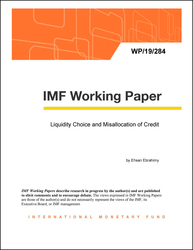
Liquidity Choice and Misallocation of Credit
This paper studies a novel type of misallocation of credit between investments of varying liquidity. One type of investment is more liquid, i.e., its return is more pledgeable, and the other is more productive. Low liquidities of both investment types imply that the allocation of credit is constrained inefficient and that there is overinvestment in the liquid type. Constrained inefficient equilibria feature non-positive, i.e., one less than or equal the economy’s growth rate, and yet too high interest rate, too much investment and too little consumption. Financial development can reduce long-term welfare and output in a constrained inefficient equilibrium if it raises the liquidity of the liquid type. I show a maximum liquid asset ratio or a simple debt tax can achieve constrained efficiency. Introducing government bonds can make Pareto improvement whenever it does not raise the interest rate.
Publication date: December 2019
ISBN: 9781513521480
$18.00
Add to Cart by clicking price of the language and format you'd like to purchase
Available Languages and Formats
| English |
Prices in red indicate formats that are not yet available but are forthcoming.
Topics covered in this book
This title contains information about the following subjects.
Click on a subject if you would like to see other titles with the same subjects.
WP , financial development , competitive equilibrium , liquid equilibrium , Tirole , tangible asset
Summary
Copyright © 2010 - 2024
Powered by:
AIDC



